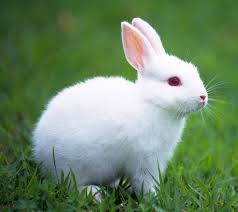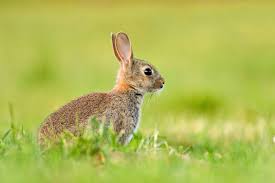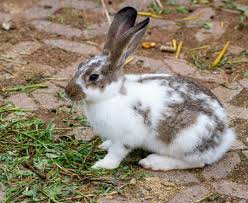Rabbits are used for meat production, vocational projects, laboratory research, teaching tools, and as pets. Due to their diverse uses, it is essential to understand various aspects of their management and nutrition. A rabbit is a swift-moving, small herbivorous mammal with large ears, strong hind legs, prominent front teeth, and a short tail.
Their powerful hind legs are designed for running, jumping, and digging burrows. Rabbits possess an excellent sense of smell, hearing, and eyesight, although their night vision is inferior to that of humans. As crepuscular animals, they are most active during twilight. Rabbits range in size from 30 to 60 cm (one to two feet) in length.
Hares are often mistakenly included under the term “rabbit,” but they belong to different genera. Hares have longer ears, larger feet, do not live in burrows, and give birth to young that are fully furred and have open eyes at birth (precocial).
Taxonomy of Rabbits
Phylum: Chordata
Sub-phylum: Vertebrata
Class: Mammalia
Order: Lagomorpha
Family: Leporidae
Genus: Oryctolagus
Species: Oryctolagus cuniculus
Domestic rabbits originated from wild rabbits found in Mediterranean regions and were introduced into England in the late 11th and early 12th centuries. Various breeds of domestic rabbits began emerging as early as the 18th century. In the early 1960s, the United States Department of Agriculture (USDA) facilitated the introduction of more rabbits to Western Nigeria.
Read Also: Amazon Flowers: All You Need To Know About
Advantages of Rabbit Keeping

1. Fast Growth Rate: Rabbits reach maturity quickly.
2. High-Quality Protein Source: Rabbit meat is a cheap and efficient source of protein. China leads the world in rabbit meat production, accounting for 31% of global output.
3. Multiple Uses: Rabbits can be raised for meat, commercial purposes, and research. In the United States, they are primarily used for pets, medical and cosmetic research, and high-quality fur.
4. Lean and Nutritious Meat: Rabbit meat is fine-grained, white, high in protein, and low in fat. The World Health Organization recognizes it as the leanest and healthiest meat. It also has low cholesterol levels.
5. Efficient Feed Conversion: Rabbits require minimal feed to produce high-quality meat.
6. Economic Viability: Due to their small size and high reproductive rate, rabbits provide a sustainable source of income for small-scale farmers.
Read Also: Pumpkin Flowers (Pumpkin Blossoms): Complete Growing and Care Guide
Characteristic of Domestic Rabbit

Rabbits have large eyes positioned on the sides of their heads, offering a 360° field of vision except for a blind spot at the tip of their nose. Their vision is adapted to detect movement from a distance, although their depth perception and close-range vision are limited. Rabbits are crepuscular, meaning they are most active at dawn and dusk.
This adaptation helps them evade both nocturnal and diurnal predators. Their vision is particularly sensitive to blue and green hues found during twilight hours.
Rabbits possess a third eyelid, known as the nictitating membrane, which provides protection and lubrication. Like other herbivores, rabbits spend considerable time grazing and re-ingesting caecal pellets to maximize nutrient absorption.
Their continuously growing teeth function like chisels, efficiently clipping vegetation. The incisors grow at a rate of 10 to 12 cm (3.9 to 4.7 inches) per year, with the enamel-covered anterior side wearing down more slowly than the posterior side, maintaining a sharp cutting edge.
Rabbits are territorial and live in loosely organized social groups. Within a warren, female and male hierarchies are separate.
Fighting to establish dominance is rare in established colonies, except during disputes over mating rights or burrows. Territorial marking is done using scent glands located under the chin, around the anus, and in the inguinal region.
When threatened, a rabbit on sentry duty will thump the ground with its hind legs to alert others. In response, rabbits may freeze, run for cover, or seek shelter in burrows. In self-defense, both males and females can kick, bite, and spray urine.
While escaping predators, rabbits initially run in a straight line before making sudden side jumps. Over longer distances, they adopt wide circular running patterns. Pregnant females produce minimal scent as a natural defense mechanism against predators.
Feed Digestion in Rabbits
Rabbits are hindgut fermenters, adapted to digest fibrous, low-quality food such as grass. Unlike other fermenters, they have a high digestive flow rate, reducing the need to store large amounts of food in their bodies.
This adaptation allows them to remain small, lightweight, and fast-moving. Their digestive system efficiently separates large particles from small ones, fermenting the latter to maximize nutrient extraction. This minimizes the time rabbits spend feeding in open areas, reducing exposure to predators.
Rabbits consume a wide range of vegetation, including leaves, shoots, herbs, grasses, grains, leaf buds, bark, stems, and vegetables such as lettuce, beets, carrots, and cabbage.
Unlike their European counterparts that dig burrows, North American rabbits create shallow, fur-lined nests called “forms” on the ground, hidden in dense vegetation. European wild rabbits, in contrast, live in complex underground tunnel systems known as warrens.
Raising rabbits (Oryctolagus cuniculus) offers numerous advantages, particularly in tropical regions where small-scale farming is common. Their high-quality, low-cholesterol meat is a healthier alternative to other protein sources.
As hindgut fermenters, rabbits can efficiently digest fibrous feed, though supplementary nutrition is essential for optimal productivity. With proper management, rabbit farming can be a sustainable and profitable venture for farmers.
Do you have any questions, suggestions, or contributions? If so, please feel free to use the comment box below to share your thoughts. We also encourage you to kindly share this information with others who might benefit from it. Since we can’t reach everyone at once, we truly appreciate your help in spreading the word. Thank you so much for your support and for sharing!

